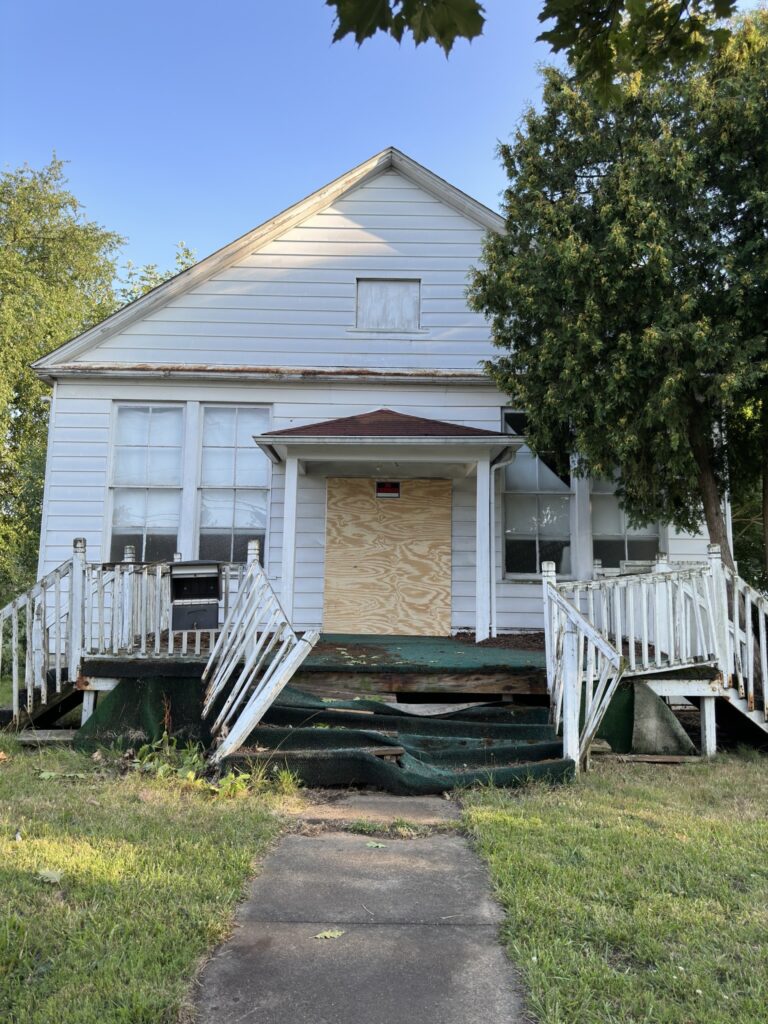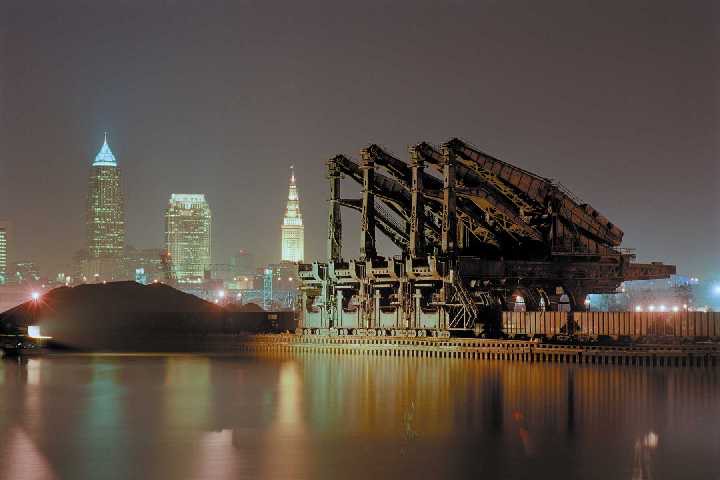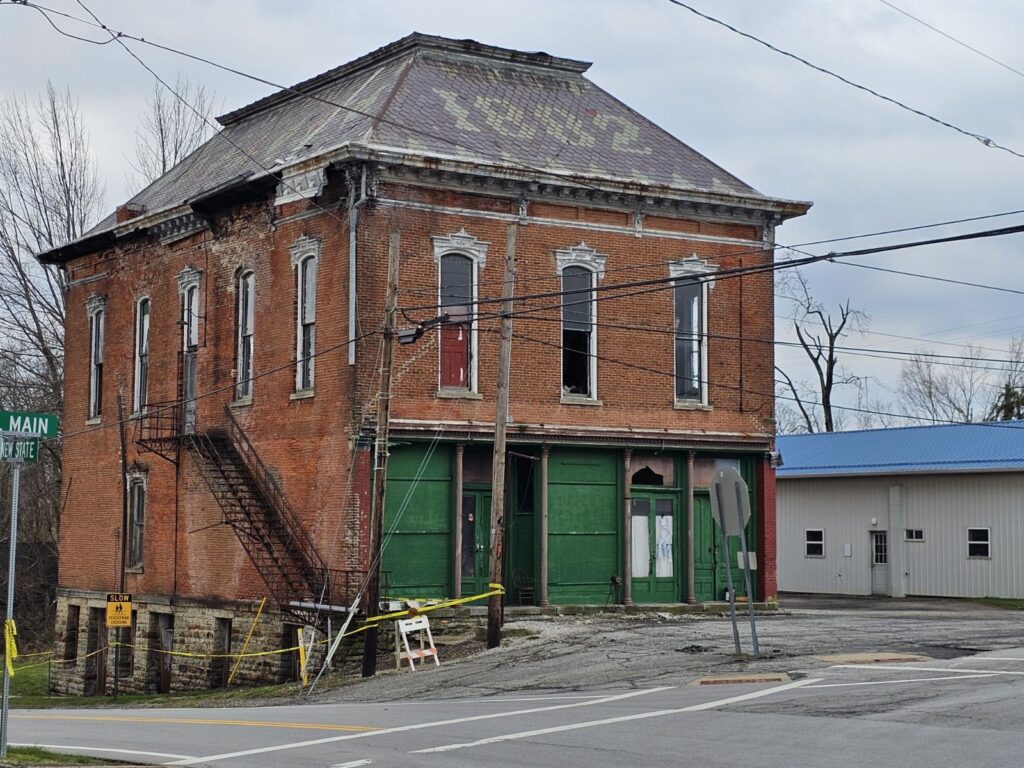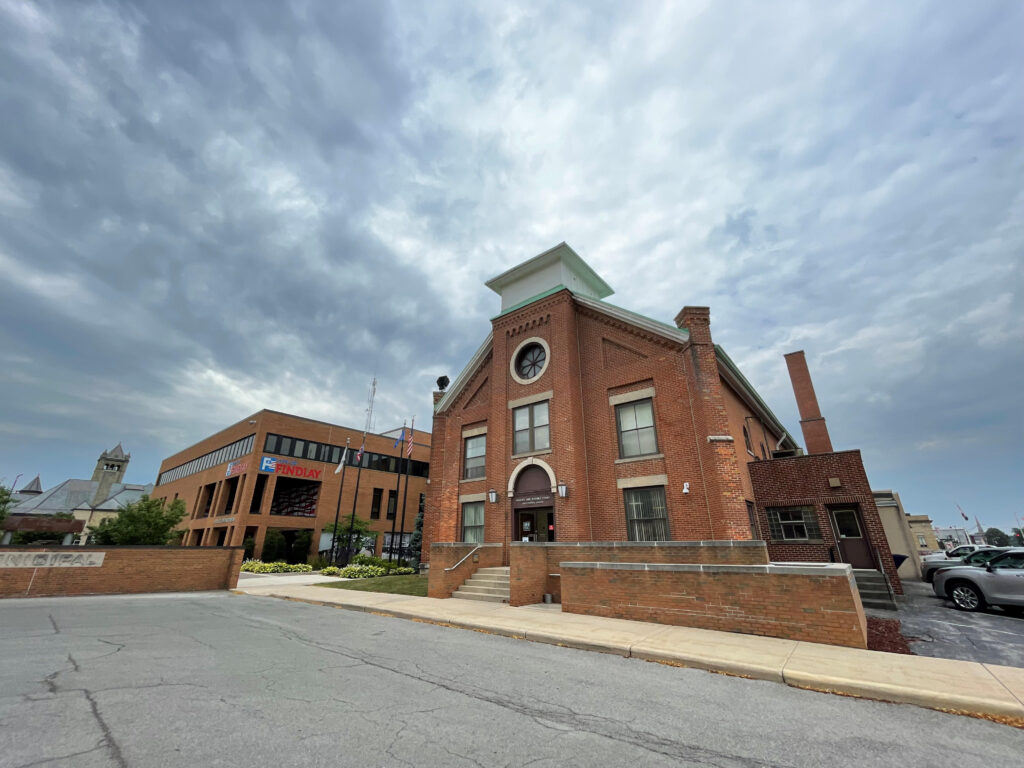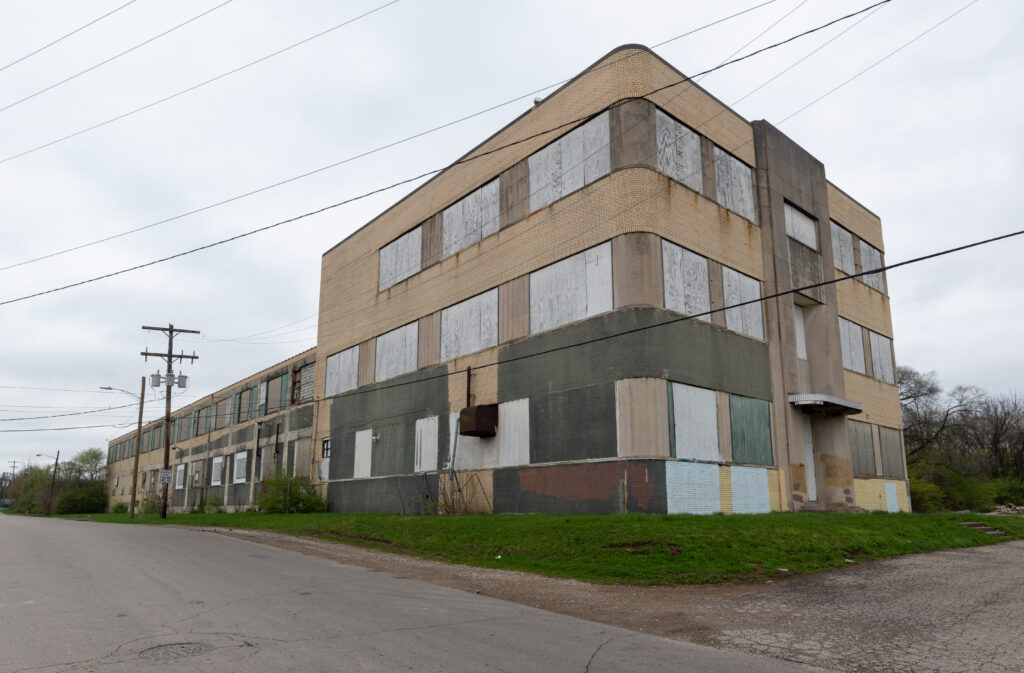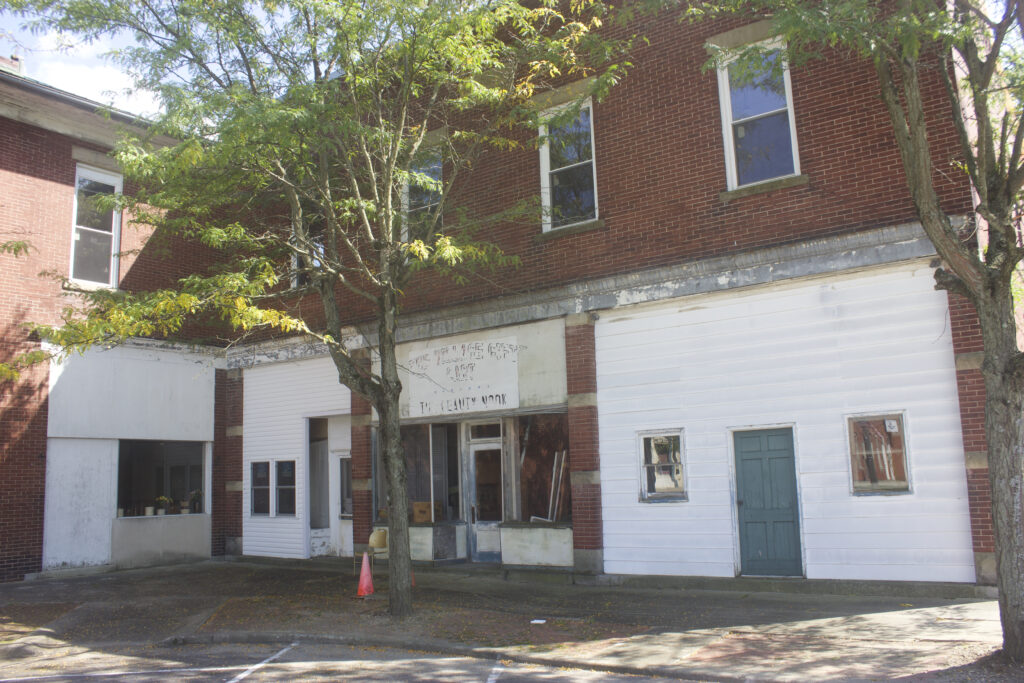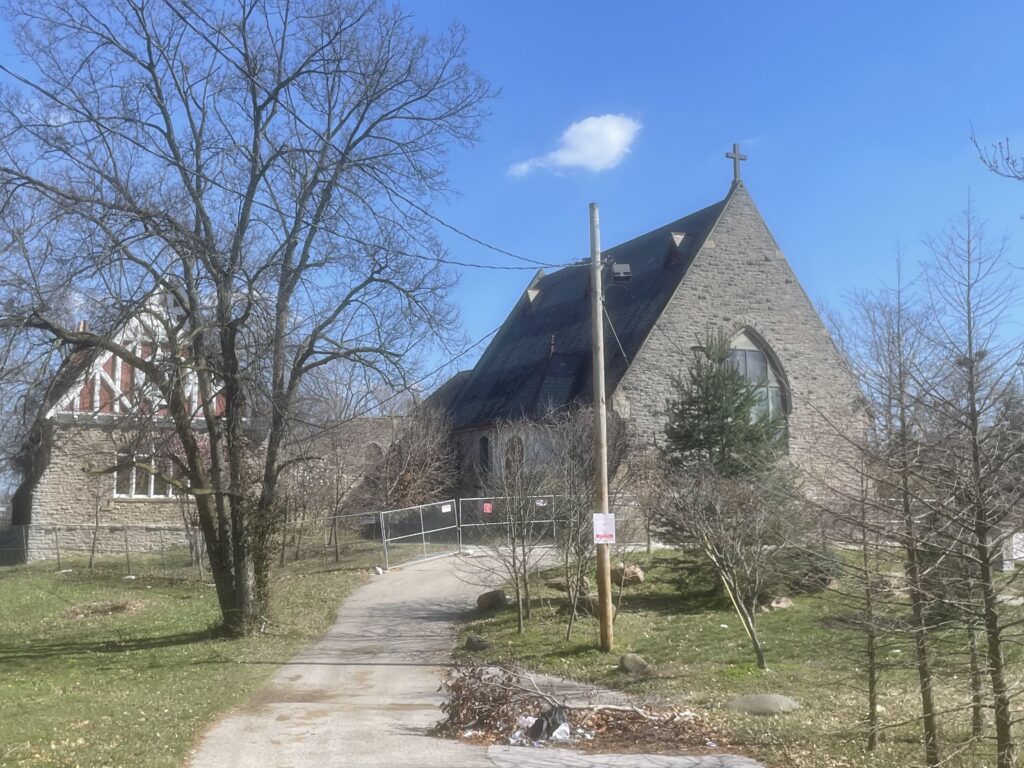Columbus, OH (May 14, 2024) – Preservation Ohio, the state’s original statewide historic preservation organization, has announced the official List of Ohio’s Most Endangered Historic Sites for 2024.
Over thirty years ago, Ohio’s statewide preservation organization was looking for ways to increase the visibility of local historic sites at risk of loss. The goal was to promote reinvestment in Ohio’s past while also highlighting the ways in which that history was neglected, ignored, or undervalued. The first Ohio’s Most Endangered Historic Sites list was published in 1993.
The list has proven to be a remarkable success over the last 31 years. Many sites across Ohio remain standing and part of the fabric of our cities, towns, rural areas, and landscapes because of the spotlight afforded properties like the John T. Wilson house in Adams County; the Westcott House (Frank Lloyd Wright’s only Prairie style commission in the state); the Historic Unionville Tavern on the Lake/Ashtabula County border; and the Athenaeum in downtown Columbus. True, several have been lost, but none without some degree of attention and focus.
This year, Preservation Ohio again received a record number of nominations for this important list. This confirms that the future of Ohio’s past is anything but a given. Ohio’s Most Endangered Historic Sites is unique among such lists nationwide in that it highlights historic buildings and sites submitted from local citizens and advocates, each hoping to bring attention and to identify ways to give important historic properties a future. Out of the many properties nominated this year, Preservation Ohio’s board was tasked with choosing the most at risk. Fourteen properties representing all areas of Ohio are included in this years edition.
Since its inception in 1993, being named to the list has contributed to saving examples of Ohio’s architectural, cultural and natural heritage. Circumstances that contribute to the endangered status and result in sites being named to the list typically include one or more of the following factors: demolition threat, abandonment, neglectful owner, deterioration, obsolete use, lack of funding for repairs, location or development.
About Preservation Ohio – Preservation Ohio is Ohio’s oldest and original statewide historic preservation organization, an independent, non-profit organization recognized under Section 501 (c) (3) of the Internal Revenue Code. Preservation Ohio was established in 1982 to enhance the understanding of and appreciation for Ohio’s historic resources and to serve as a focal point for Ohio organizations, municipalities, corporations and individuals who care about these resources and are concerned about preservation for future generations. For more information and updates, visit our website at www.preserveohio.com, follow us on Twitter @PreservationOH, or like us on Facebook. Preservation Ohio is celebrating its 42nd Anniversary this May.
All of the information below is taken from each site’s nomination form. For previous years’ lists, click here. Click any image below for a larger view. More information is available by contacting Thomas Palmer, Executive Director, at: thomasp@preserveohio.com.
The 2024 List of Ohio’s Most Endangered Historic Sites
A.A. Cunningham House/Tiffin City Schools Administration Building — Tiffin, Seneca County
Lawndale Schoolhouse — Akron, Summit County
Hulett Iron Ore Unloaders — Cleveland, Cuyahoga County
Hoyt Building — North Fairfield, Huron County
AB Graham Memorial Center — Conover, Miami County
171-191 S. High Street — Columbus, Franklin County
Hancock County Probate Court — Findlay, Hancock County
Hill Memorial, Ohio Northern University — Ada, Hardin County
Firestone Plant 1 — Akron, Summit County
Farm Crest Bakeries Building — Columbus, Franklin County
Octagon House — Tiffin, Seneca County
Masonic Block — Caledonia, Marion County
Grace Church/Gabriel’s Place — Cincinnati, Hamilton County
Hessler Court and Hessler Road Historic District — Cleveland, Cuyahoga County
A.A. Cunningham House/Tiffin City Schools Administration Building
Tiffin — Seneca County
The home was built by A.A. Cunningham. Cunningham was one half of the “Sneath & Cunningham Company” which built and operated 3 elevators in Tiffin, one for seed and the other 2 reserved for grain. They also had 37 other elevators within a 60 mile radius of Tiffin. Cunningham was also president of the Commercial National Bank in Tiffin. The impending threat is demolition because the school wants to build a new school on the site. The goal is to move the home to another area in Tiffin. More information and views of the structure can be found here.
Lawndale Schoolhouse
Akron — Summit County
Building was built as an original one room school house for Coventry Township in 1896. When the Village of Kenmore was carved out of Coventry Township it became part of the Kenmore School District until it was replaced by a bigger school in 1912. The bigger school was closed in 2016 and left to rot until it burned down in 2022. This is one of the last original one room schoolhouses left in the area. The Kenmore Historical Society is prepared to make an investment and have fundraisers in order to have the financial means necessary to make an improvement on the building.
Hulett Iron Ore Unloaders
Cleveland – Cuyahoga County
The historic properties that are in danger are 2 Hulett Ore Unloaders, industrial cranes that unloaded iron ore from Great Lakes carriers. Previously on the dock face as a battery of four, 2 were scrapped in 2000, and the 2 being nominated are dismantled and in storage at the back of the ore handling facility. They have the potential to be made operational again. Unfortunately, the site was not maintained and the Huletts were in a forest of trees and undergrowth until March, 2024, when the site was cleared for demolition. The Port has stated that the clock has run out on storing the Huletts. The Port received bids for the scrapping of the Huletts and scrapping is expected to begin immediately.
Hoyt Building
North Fairfield, Huron County
The Hoyt building is a two story Victorian building that is currently derelict and being used as storage by its owner. The building has been left to deteriorate for some time, to the point that pieces of the facade have begun to fall. The village has applied for a grant form the county land bank for the demolition and the bank has done testing on the property to determine what possible contaminants would result from its demolition. Hope is hope that being listed will garner community support for a preservation effort and demonstrate to the owner and the village that the building is worth saving.
AB Graham Memorial Center
Conover, Miami County
The building is currently used as a community center and museum of Albert Graham founder of 4-H clubs of America. The center has very little money to maintain the facility and the current owners Brown Township trustees plans are not to put money into the facility any longer. The biggest part of maintaining this facility is to have possibly the township trustees continue to maintain the building and find outside sources for funding. Google Maps view is below.
171-191 S. High Street
Columbus, Franklin County
Currently these are vacant buildings with exteriors in excellent condition. The storefronts have been modified numerous times, and so it is unknown if any original details remain, however the remaining portions of the buildings exist entirely as they did over 100 years ago. The Lazarus company, Columbus’ landmark department store, was founded at this site in 1851, and remained here until 1909. The developer owns the property and plans to demolish the buildings. It still needs approval from the Downtown Commission before demolition, and the Historic Resources Commission may have to weigh in, as the developer plans to renovate the neighboring historic Ohio National Bank as part of the same project. Google Maps view is below.
Hancock County Probate Court
Findlay, Hancock County
This building was originally built as the First Congregational Church. The church purchased a lot next to the Courthouse, where they built this beautiful building. Eventually the church disorganized in the mid 1880s. The County is currently building a new building to house the Probate and Juvenile Courts due to lack to space in the current building. This may be the oldest still standing religious structure in Hancock County. A number of people in the community would like to see it saved, including historical organizations.
Hill Memorial, Ohio Northern University
Ada, Hardin County
Hill Memorial is an academic building at the front of the ONU campus. Located along Ada’s Main Street, Hill has long served as the iconic image of ONU. Originally constructed in 1879, Hill Memorial stands as the last remaining structure from the institution’s original name, the Northwestern Ohio Normal School. Its approximately 12,500 square feet span two floors and additional space in the clock tower and basement. While the foundation may need some attention, the core structural integrity is sound. The university held classes in the building this spring. A consultant recently recommended that Hill be demolished because of a stated restoration cost of $9 million. Some faculty members, current students, alumni, and local residents believe this to be an overestimate to discourage dissent to demolition. There is also a question about the consultant’s restoration qualifications as the recommendation was a small part of a larger campus master plan initiative. A Google Maps view is below.
Firestone Plant 1
Akron, Summit County
The buff-brick building was built in 1910 with the addition of a clock tower in the 1920s. The plant was home to the Firestone Tire & Rubber Company and stands today as a relic of Akron’s rubber heritage. The city currently owns it and it’s been vacant for about a decade or so, but the building is salvageable. The back of the building could possibly be selectively demolished and the front building with the clock tower can be adaptively reused. Local preservation groups are involved in advocating for a future of the building. Google Maps view below.
Farm Crest Bakeries Building
Columbus, Franklin County
The building is an exemplary instance of Streamline Moderne architecture, and is the only significant remaining structure in this style in the region. It has been vacant for several years. Its evident condition involves some cosmetic problems – paint that can be removed, boarded windows/doors that can be repaired. There are no known larger problems. This threat is imminent with a demolition permit issued earlier this year. The developer plans to tear down the entire building and replace it with a commonplace five-over-one style apartment building with accompanying surface lot parking.
Octagon House
Tiffin, Seneca County
The Octagon House is on the Heidelberg University campus and is not being used for anything other than storage currently. Due to the current state of the outside of the building it will be un-salvageable in the next couple years. The Octagon was constructed in 1852, and other than Founders Hall, it was the first building constructed on Heidelberg’s campus. Constructed along with the President’s House and the Gerhart-Rust Residence, it was, like the others, intended to be used as faculty housing. There is an organization that is willing to donate land for the house to be placed on. Google Maps view below.
Masonic Block
Caledonia, Marion County
Built after a downtown fire, Caledonia’s Masonic Block Building (1897) was the long-time home of Caledonia’s Oliver Lodge #447 of F&A Masons, with three storefronts at street level. The Masonic Block restoration project — estimated at just over $1,000,000 — is now underway; Phase 1 was completed last fall. Council members want to see clear progress on the project to get the building rehabilitated and back online soon; however, fundraising remaining project costs and finding qualified, available contractors is a major obstacle. With the historic tax credits clock ticking, Public Square Heritage Futures, LLC. is facing an uphill battle in finding a syndicator or bridge loan to help transform those back-end historic tax credits into usable project capital for Phase 2 & Phase 3. The building’s future use will be as a community arts & culture center & incubator serving Marion County & the broader North-Central Ohio region. View below; Masonic Block is on right.
Grace Church/Gabriel’s Place
Cincinnati, Hamilton County
This is a vacant historic Episcopal church complex in a gentrifying low-income African American neighborhood. The complex consists of two buildings–a church building and a separate rectory, both built in 1869. The building is in good condition though it is vacant and currently surrounded by construction fencing. The goal is to call attention to imminent developer demolition plans before it is too late. If the community were aware of the alternate plans, they would push to save this important historic building. Cincinnatians across generations care deeply about this building for both its architectural and artistic merit.
Hessler Court and Hessler Road Historic District
Cleveland, Cuyahoga County
Hessler Court and Hessler Road are wood block and red clay brick roads joining to form an enclave of early twentieth century wood frame singles and doubles and terraces and apartment buildings. It was built as a middle class addition to an otherwise fashionable neighborhood. It’s Cleveland’s first Historic Landmark District. Over the past three years, Hessler suffered its first demolition and development to appease the insatiable demand for student housing in the neighborhood. The threat of demolition by neglect and development have been looming for decades. The goal for listing is to raise awareness about all the threatened resources in the University Circle neighborhood and preserving our historic, affordable housing stock and the cultures that occupy them. Photo below from Preservation Ohio 2021 site visit.
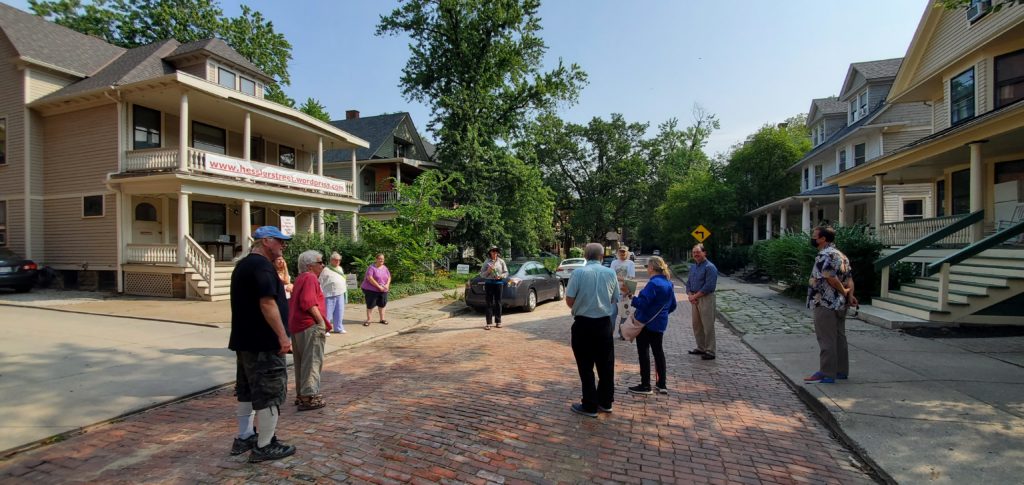
Photo: Hill Memorial Building, Ohio Northern University, Ada – Creative Commons License


